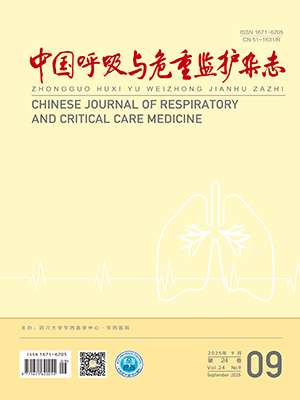| 1. |
Templeton KE, Scheltinga SA, van den Eeden WC, et al. Improved diagnosis of the etiology of community-acquired pneumonia with real-time polymerase chain reaction. Clin Infect Dis, 2005, 41(3): 345-351.
|
| 2. |
Karhu J, Ala-Kokko TI, Vuorinen T, et al. Lower respiratory tract virus findings in mechanically ventilated patients with severe community-acquired pneumonia. Clin Infect Dis, 2014, 59(1): 62-70.
|
| 3. |
Jennings LC, Anderson TP, Beynon KA, et al. Incidence and characteristics of viral community-acquired pneumonia in adults. Thorax, 2008, 63(1): 42-48.
|
| 4. |
Johansson N, Kalin M, Tiveljung-Lindell A, et al. Etiology of community-acquired pneumonia: increased microbiological yield with new diagnostic methods. Clin Infect Dis, 2010, 50(2): 202-209.
|
| 5. |
Lieberman D, Shimoni A, Shemer-Avni Y, et al. Respiratory viruses in adults with community-acquired pneumonia. Chest, 2010, 138(4): 811-816.
|
| 6. |
Katsurada N, Suzuki M, Aoshima M, et al. The impact of virus infections on pneumonia mortality is complex in adults: a prospective multicentre observational study. BMC Infect Dis, 2017, 17(1): 755.
|
| 7. |
Wang K, Xi W, Yang D, et al. Rhinovirus is associated with severe adult community-acquired pneumonia in China. J Thorac Dis, 2017, 9(11): 4502-4511.
|
| 8. |
Jacobs SE, Soave R, Shore TB, et al. Human rhinovirus infections of the lower respiratory tract in hematopoietic stem cell transplant recipients. Transpl Infect Dis, 2013, 15(5): 474-486.
|
| 9. |
中华医学会呼吸病学分会. 社区获得性肺炎诊断和治疗指南(2006 年版). 中华结核和呼吸杂志, 2006, 29(10): 651-655.
|
| 10. |
Hohenadel IA, Kiworr M, Genitsariotis R, et al. Role of bronchoalveolar lavage in immunocompromised patients with pneumonia treated with a broad-spectrum antibiotic and antifungal regimen. Thorax, 2001, 56(2): 115-120.
|
| 11. |
Rañó A, Agustí C, Benito N, et al. Prognostic factors of non-HIV immunocompromised patients with pulmonary infiltrates. Chest, 2002, 122(1): 253-261.
|
| 12. |
Sousa D, Justo I, Domínguez A, et al. Community-acquired pneumonia in immunocompromised older patients: incidence, causative organisms and outcome. Clin Microbiol Infect, 2013, 19(2): 187-192.
|
| 13. |
Patterson TF, Thompson GR, Denning DW, et al. Practice Guidelines for the Diagnosis and Management of Aspergillosis: 2016 Update by the Infectious Diseases Society of America. Clin Infect Dis, 2016, 63(4): e1-e60.
|
| 14. |
胡华, 杨燕, 滕隔玲, 等. 支气管肺泡灌洗液半乳甘露聚糖抗原检测在肺曲霉病诊断中的价值. 中华医学杂志, 2012, 92(32): 2268-2270.
|
| 15. |
奚志敏, 沈军, 王立波, 等. 人鼻病毒感染研究进展. 中华实验和临床病毒学杂志, 2016, 30(3): 333-336.
|
| 16. |
Seo S, Waghmare A, Scott EM, et al. Human rhinovirus detection in the lower respiratory tract of hematopoietic cell transplant recipients: association with mortality. Haematologica, 2017, 102(6): 1120-1130.
|
| 17. |
汪志方, 朱晓萍. 人鼻病毒与慢性阻塞性肺疾病急性加重的相关性研究进展. 中华结核和呼吸杂志, 2016, 39(2): 140-142.
|
| 18. |
杜小兵, 马旭, 高杨, 等. 慢性阻塞性肺疾病急性加重期呼吸道病毒感染检出率及危险因素分析. 中华结核和呼吸杂志, 2017, 40(4): 263-266.
|
| 19. |
Ishizuka S, Yamaya M, Suzuki T, et al. Effects of rhinovirus infection on the adherence of Streptococcus pneumoniae to cultured human airway epithelial cells. J Infect Dis, 2003, 188(12): 1928-1939.
|
| 20. |
Qu JX, Gu L, Pu ZH, et al. Viral etiology of community-acquired pneumonia among adolescents and adults with mild or moderate severity and its relation to age and severity. BMC Infec Dis, 2015, 15(1): 89.
|
| 21. |
Hohenthal U, Vainionpää R, Nikoskelainen J, et al. The role of rhinoviruses and enteroviruses in community acquired pneumonia in adults. Thorax, 2008, 63(7): 658-659.
|
| 22. |
Choi SH, Hong SB, Ko GB, et al. Viral infection in patients with severe pneumonia requiring intensive care unit admission. Am J Respir Crit Care Med, 2012, 186(4): 325-332.
|
| 23. |
Hung HM, Yang SL, Chen CJ, et al. Molecular epidemiology and clinical features of rhinovirus infections among hospitalized patients in a medical center in Taiwan. J Microbiol Immunol Infect, 2019, 52(2): 233-241.
|
| 24. |
Schauwvlieghe AFAD, Rijnders BJA, Philips N, et al. Invasive aspergillosis in patients admitted to the intensive care unit with severe influenza: a retrospective cohort study. Lancet Respir Med, 2018, 6(10): 782-792.
|
| 25. |
Ivan H, Anna Z, Kelvin T, et al. Unexpectedly higher morbidity and mortality of hospitalized elderly patients associated with rhinovirus compared with influenza virus respiratory tract infection. Int J Mol Sci, 2017, 18(2): piiE259.
|
| 26. |
Choi SH, Huh JW, Hong SB. Clinical characteristics and outcomes of severe rhinovirus-associated pneumonia identified by bronchoscopic bronchoalveolar lavage in adults: comparison with severe influenza virus-associated pneumonia. J Clin Virol, 2015, 62: 41-47.
|
| 27. |
Jacobs SE, Lamson DM, St George K, et al. Human rhinoviruses. Clin Microbiol Rev, 2013, 26(1): 135-162.
|
| 28. |
Grünewaldt A, Hügel C, Rohde GGU. Rhinoviruses. Internist (Berl), 2019, 60(11): 1151-1154.
|




